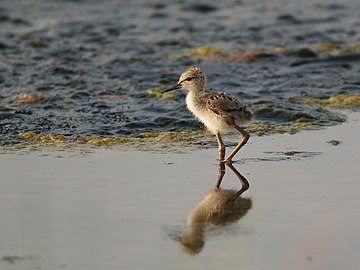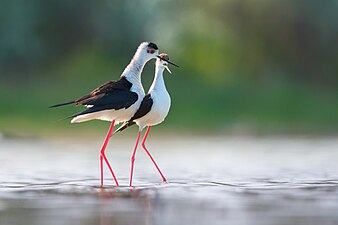
The four species of avocets are a genus, Recurvirostra, of waders in the same avian family as the stilts. The genus name comes from Latin recurvus, 'curved backwards' and rostrum, 'bill'. The common name is thought to derive from the Italian (Ferrarese) word avosetta. Francis Willughby in 1678 noted it as the "Avosetta of the Italians".

Stilt is a common name for several species of birds in the family Recurvirostridae, which also includes those known as avocets. They are found in brackish or saline wetlands in warm or hot climates.

The garganey is a small dabbling duck. It breeds in much of Europe and across the Palearctic, but is strictly migratory, with the entire population moving to Africa, India, Bangladesh and Australasia during the winter of the Northern hemisphere, where large flocks can occur. This species was first described by Carl Linnaeus in his landmark 1758 10th edition of Systema Naturae. Like other small ducks such as the Eurasian teal, this species rises easily from the water with a fast twisting wader-like flight.

The common shelduck is a waterfowl species of the shelduck genus, Tadorna. It is widespread and common in the Euro-Siberian region of the Palearctic, mainly breeding in temperate and wintering in subtropical regions; in winter, it can also be found in the Maghreb.

The common redshank or simply redshank is a Eurasian wader in the large family Scolopacidae.

The American avocet is a large wader in the avocet and stilt family, Recurvirostridae, found in North America. It spends much of its time foraging in shallow water or on mud flats, often sweeping its bill from side to side in water as it seeks crustacean and insect prey.

The killdeer is a large plover found in the Americas. It gets its name from its shrill, two-syllable call, which is often heard. It was described and given its current scientific name in 1758 by Carl Linnaeus in the 10th edition of his Systema Naturae. Three subspecies are described. Its upperparts are mostly brown with rufous fringes, the head has patches of white and black, and two black bands cross the breast. The belly and the rest of the breast are white. The nominate subspecies breeds from southeastern Alaska and southern Canada to Mexico. It is seen year-round in the southern half of its breeding range; the subspecies C. v. ternominatus is resident in the West Indies, and C. v. peruvianus inhabits Peru and surrounding South American countries throughout the year. North American breeders winter from their resident range south to Central America, the West Indies, and the northernmost portions of South America.

The dunlin is a small wader, formerly sometimes separated with the other "stints" in the genus Erolia. The English name is a dialect form of "dunling", first recorded in 1531–1532. It derives from dun, "dull brown", with the suffix -ling, meaning a person or thing with the given quality.
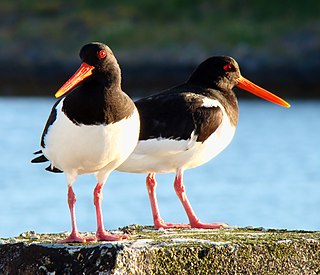
The Eurasian oystercatcher also known as the common pied oystercatcher, or just oystercatcher, is a wader in the oystercatcher bird family Haematopodidae. It has striking black and white plumage, a long straight orange-red bill, red eyes and relatively short dull pink legs. The sexes are similar in appearance but the bill of the female is longer than that of the male.

The lesser black-backed gull is a large gull that breeds on the Atlantic coasts of Europe. It is migratory, wintering from the British Isles south to West Africa. However, it has increased dramatically in North America, especially along the east coast. Formerly just a winter visitor to North America, it has increased and occurs in large numbers some winters and birds are now recorded year-round. However, there is serious concern about decline in many parts of its range. The species is on the UK Amber List because the UK is home to 40 per cent of the European population and more than half of these are found at fewer than ten breeding sites.
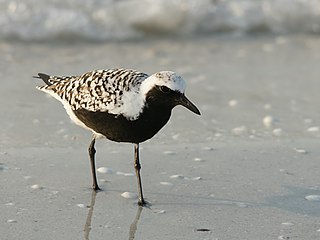
The grey plover or black-bellied plover is a large plover breeding in Arctic regions. It is a long-distance migrant, with a nearly worldwide coastal distribution when not breeding.

The European golden plover, also known as the European golden-plover, Eurasian golden plover, or just the golden plover within Europe, is a relatively large species of plover. This species is similar to two other golden plovers: the American golden plover, Pluvialis dominica, and Pacific golden plover, Pluvialis fulva, which are both smaller, slimmer and relatively longer-legged than European golden plover, and both have grey rather than white axillary feathers.

The red-necked phalarope, also known as the northern phalarope and hyperborean phalarope, is a small wader. This phalarope breeds in the Arctic regions of North America and Eurasia. It is migratory, and, unusually for a wader, winters at sea on tropical oceans.

The pied avocet is a large black and white wader in the avocet and stilt family, Recurvirostridae. They breed in temperate Europe and across the Palearctic to Central Asia then on to the Russian Far East. It is a migratory species and most winter in Africa or southern Asia. Some remain to winter in the mildest parts of their range, for example in southern Spain and southern England. The pied avocet is one of the species to which the Agreement on the Conservation of African-Eurasian Migratory Waterbirds (AEWA) applies.

The Eurasian stone-curlew, Eurasian thick-knee, or simply stone-curlew is a northern species of the Burhinidae (stone-curlew) bird family.

The Eurasian dotterel, also known in Europe as just dotterel, is a small wader in the plover family of birds. It is the only species placed in the genus Eudromias.
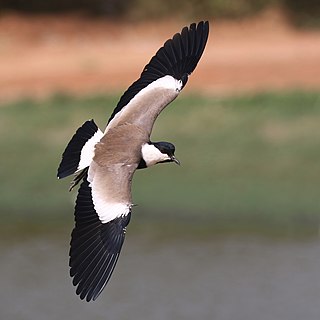
The spur-winged lapwing or spur-winged plover is a lapwing species, one of a group of largish waders in the family Charadriidae.

The Andean avocet is a large wader in the avocet and stilt bird family, Recurvirostridae. It is resident in the Andes, breeding above 3500 m in northwestern Argentina, western Bolivia, northern Chile and southern Peru.
In the 10th edition of Systema Naturae, published in 1758, the Swedish naturalist Carl Linnaeus described 554 species of bird and gave each a binomial name.
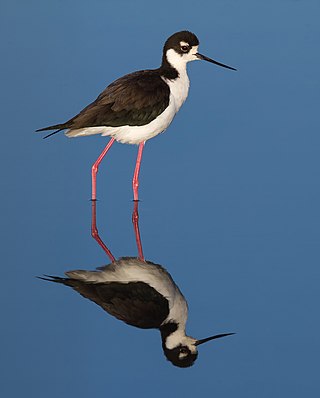
The black-necked stilt is a locally abundant shorebird of American wetlands and coastlines. It is found from the coastal areas of California through much of the interior western United States and along the Gulf of Mexico as far east as Florida, then south through Central America and the Caribbean to Brazil, Peru and the Galápagos Islands, with an isolated population, the Hawaiian stilt, in Hawaii. The northernmost populations, particularly those from inland, are migratory, wintering from the extreme south of the United States to southern Mexico, rarely as far south as Costa Rica; on the Baja California peninsula it is only found regularly in winter. Some authorities, including the IUCN, treat it as a synonym of Himantopus himantopus.






